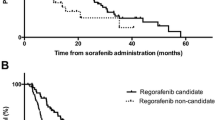Abstract
Purpose
We compared the efficacy and safety of sorafenib in patients with Child-Pugh (CP) class B and CP class A.
Methods
Clinical data from 267 patients with HCC who had been treated with sorafenib were reviewed. Patients were grouped according to CP score (5–6, 7, and 8–9), and their tumor response, tolerance, and survival were assessed.
Results
Median patient age was 55 years, and 87.6% were men. Gender, HCC etiology, and extrahepatic metastasis did not differ according to CP score. Of the 225 evaluable patients, 4 achieved partial response and 121 achieved stable disease, making the disease control rate 46.8%. DCR was higher in patients with CP A than CP B score, but did not differ between those with CP scores of 7 and 8–9. The incidence rates of grade 3/4 toxicities did not differ according to CP score. Many patients with CP score 8–9 (26.3%) had to stop sorafenib due to cirrhosis-related complications. At a median follow-up of 15.6 months, the median time to progression and overall survival of all patients were 2.6 and 7.9 months, respectively. OS was greater in patients with CP score 5–6 than in patients with CP scores of 7 or 8–9.
Conclusions
Sorafenib efficacy and survival outcomes were worse in patients with CP B function. Patients with a CP score of 7 had the same incidence of adverse events and cirrhosis-related complications as those with CP A liver function, suggesting that the former can be included in clinical trials of new agents.


Similar content being viewed by others
References
Bruix J, Sherman M (2005) Management of hepatocellular carcinoma. Hepatology 42:1208–1236
Cheng A-L, Kang Y-K, Chen Z, Tsao C-J, Qin S, Kim JS et al (2009) Efficacy and safety of sorafenib in patients in the Asia-Pacific region with advanced hepatocellular carcinoma: a phase III randomised, double-blind, placebo-controlled trial. Lancet Oncol 10:25–34
Duffaud F, Therasse P (2000) New guidelines to evaluate the response to treatment in solid tumors. Bull Cancer 87:881–886
Lee S, Kang Y, Chang H, Lee J, Kim T, Kim J, Kim K, Lee H, Lee Y, Suh D (2009) Sorafenib in patients with advanced hepatocellular carcinoma: experience in a single institute. 2009 gastrointestinal cancers symposium 256
Llovet JM, Ricci S, Mazzaferro V, Hilgard P, Gane E, Blanc J-F et al (2008) Sorafenib in advanced hepatocellular carcinoma. N Engl J Med 359:378–390
Ozenne V, Paradis V, Pernot S, Castelnau C, Vullierme MP, Bouattour M et al (2010) Tolerance and outcome of patients with unresectable hepatocellular carcinoma treated with sorafenib. Eur J Gastroenterol Hepatol 22(9):1106–1110
Shim JH, Park JW, Choi JI, Park BJ, Kim CM (2009) Practical efficacy of sorafenib monotherapy for advanced hepatocellular carcinoma patients in a Hepatitis B virus-endemic area. J Cancer Res Clin Oncol 135:617–625
Conflict of interest
None.
Author information
Authors and Affiliations
Corresponding author
Additional information
J. E. Kim and B.-Y. Ryoo contributed equally to this work.
Rights and permissions
About this article
Cite this article
Kim, J.E., Ryoo, BY., Ryu, MH. et al. Sorafenib for hepatocellular carcinoma according to Child-Pugh class of liver function. Cancer Chemother Pharmacol 68, 1285–1290 (2011). https://doi.org/10.1007/s00280-011-1616-x
Received:
Accepted:
Published:
Issue Date:
DOI: https://doi.org/10.1007/s00280-011-1616-x




